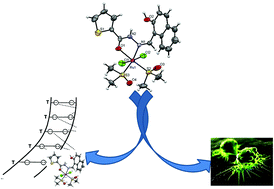DMSO containing ruthenium(ii) hydrazone complexes: in vitro evaluation of biomolecular interaction and anticancer activity†
Abstract
Synthesis, spectral, electrochemical and single crystal X-ray diffraction data of a new series of DMSO containing bivalent ruthenium hydrazone complexes are presented. XRD data of two of the new complexes revealed an octahedral coordination around the ruthenium ion satisfied by NOS2Cl2 atoms. Electrochemical studies showed the metal centred, quasi-reversible, one-electron redox behaviour of the new complexes. The binding of these complexes with biomolecules such as calf thymus DNA (CT-DNA) and bovine serum albumin (BSA) protein investigated by different spectrophotometric methods revealed an intercalative mode of interaction. The in vitro cytotoxicity of these complexes evaluated by the MTT assay on a panel of cancer and normal cell lines indicated that the above complexes are more toxic to cancer cells with a few micromolar concentrations as the IC50 value, but are significantly less toxic to normal cell lines. The observed variations in the binding interactions and cytotoxicity of the complexes were attributed to the nature of the hydrazide moiety of the hydrazones that influences their biological activities.


 Please wait while we load your content...
Please wait while we load your content...